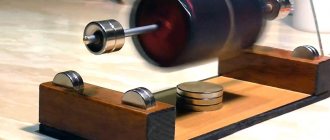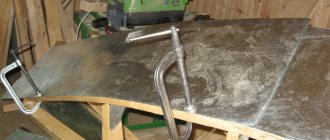How to magnetize a magnet at home
For many people, a magnet is still a mystery, although in principle people became acquainted with this metal and phenomenon a very long time ago.
Even then, a whole system for the production of various magnets was developed. Today this is far from uncommon, and even powerful magnets can be made at home. Making a magnet using improvised materials
Of course, for many this will even seem like something supernatural and may even be a shock, but even now, sitting at home, most people can make a magnet with their own hands. Below are four methods that describe how to make a powerful magnet at home.
The first and probably therefore the simplest method: to implement it, you just need to take any object that can be magnetized (the object must be metal) and move it several times along a permanent magnet, and this should be done only in one direction. But, unfortunately, such a magnet will be short-lived and will very quickly lose its magnetic properties.
This magnetization method is performed using a 5 or 12 volt battery or accumulator. Most often it is used for magnetizing screwdrivers and is performed as follows:
• A copper wire of a certain length is taken, which will be enough to wrap the screwdriver shaft 280 - 350 times. The wire from transformers, or the one intended for their production, is best suited. • The object is insulated; in this case, the entire shaft of the screwdriver is wrapped using electrical tape. • The winding itself is carried out and connected to the battery. One end is to the plus, the other to the minus. The winding should be carried out turn to turn, evenly. The insulation must also be tight.
As a result of these manipulations, it will be much more pleasant to work with a screwdriver. This operation can turn any old unnecessary screwdrivers into a truly convenient tool.
This option describes how to make a powerful magnet in a fairly simple way. In fact, it has already been fully described above, but this particular method involves a different material. In this case, ordinary metal will be used, or rather a small piece of it, preferably cubic in shape, and a more powerful coil. Now the number of turns needs to be increased 2-3 times for magnetization to be successful.
This method is very dangerous and is strictly prohibited for use by people who are not electrical professionals. It is carried out strictly in compliance with safety precautions, the main thing is to remember that only you and no one else bears responsibility for life and health.
He talks about how to make a strong magnet at home, while spending a small amount of money. In this case, an even more powerful coil, wound exclusively from copper, will be used, as well as a fuse for a 220-volt network.
The fuse is needed so that the coil can be turned off in time. Immediately after connecting to the network, it will burn out, but during this period of time it will have time to go through the magnetization process. The current strength in this case will be maximum for the network and the magnet will be quite powerful.
DIY powerful electromagnet
First, you need to figure out what it is. An electromagnet is a whole device that, when a certain current is supplied to it, works like a regular magnet. Immediately after cessation, it loses these properties. How to make a powerful magnet from an ordinary coil and iron was described above. So, if you use a magnetic circuit instead of iron, then you will get exactly the same electromagnet.
In order to figure out how to make a strong magnet at home that will work from the network, you just need to remember a little information from the school physics course and understand that as the coil, as well as the magnetic circuit, increases, the power of the magnet will also increase. But this will require more current to reveal the full potential of the magnet.
But neodymium remains the most powerful; they have all the most desirable properties and, despite their strength, are small in size and weight. How to make neodymium magnets with your own hands and whether it is even possible will be discussed further.
Making a neodymium magnet
Due to the complex composition and special production method, the question of how to make a neodymium magnet with your own hands at home disappears by itself. But many are still interested in how to make neodymium magnets, because it would seem that if you can make an ordinary magnet, then it is also quite possible to make a neodymium one.
But everything is not as simple as it seems in reality. Serious companies are engaged in the production of such magnets; they use special technologies for very powerful magnetization of the material. And this is in addition to the fact that an alloy that is quite difficult to extract and produce is used. Therefore, the answer to this question can be clearly - no way. If someone manages to do this, then he can easily open his own production, since he will already have the necessary equipment.
Application of created magnets
Application for industrial and economic purposes
Used in various electrical appliances. They are especially common in devices equipped with speakers. Any dynamic head includes a magnet, ferrite or neodymium; in rare cases, others are also used. Magnets are also used in furniture production and toys. In production, when filtering bulk materials.
Use at home
Refrigerator magnets are one of the most common uses of magnets. Also, some use them to stop meters in order to reduce utility bills, but doing so is strictly prohibited and inappropriate.
Based on this article, you can understand how to make a powerful magnet at home, without spending any special effort or material resources. But people who do not understand electricity and generally have no idea how it works should not experiment with a powerful network, because it is serious and very dangerous for human life.
Operating principle of magnetic sensors
In 1879, Edwin Hall discovered that when a current-carrying conductor is placed in a transverse magnetic field, a potential difference appears on its sides, proportional to the direction and magnitude of the magnetic induction, which is the result of the influence of the Lorentz force on moving charges (Figure 1). Until the second half of the twentieth century, this effect did not find practical application, and only in 1960 was the first industrial sensor based on this physical phenomenon introduced. From this moment on, magnetic sensors begin to be actively used in technology, becoming increasingly popular.
Rice. 1. Operating principle of the Hall sensor
Since the Lorentz force, and therefore the Hall emf, is directly related to the mobility of charges, to increase sensitivity the active element is made of semiconductor materials. Silicon is most often used, but there are also devices with an active zone made of germanium, gallium arsenide, indium phosphide and other semiconductors. The shape and geometric dimensions of the sensitive element depend on the specific purpose, therefore, there are both flat and volumetric sensors, and in the production of flat elements, the technology of vacuum deposition of conductive layers on a dielectric base has proven itself well. Despite the fact that the sensitivity and linearity of the measuring element directly depend on its size, in practice sensors with an active conductor volume greater than 1 mm 3 are rarely used, which makes these devices one of the smallest.
However, the Hall effect also has a number of disadvantages, the main of which are the relatively low output voltage, not exceeding 1000 mV/T, and temperature instability. This forces the installation of an operational amplifier, most often with thermal compensation elements, in the immediate vicinity of the measurement location, so the market most often contains ready-made solutions - microcircuits containing all the components necessary for operation and requiring a minimum number of external components (Figure 2).
Rice. 2. Block diagrams of the simplest magnetic sensors
Since the magnetic sensor chip is actually an independent measuring system-on-a-chip, no one prohibits manufacturers of electronic components from expanding its capabilities by adding various components and modules that improve both technical characteristics and functionality. Therefore, the market contains both simple sensors with an analogue or discrete output, as well as entire measuring systems with their own signal processors and non-volatile memory for storing settings, supporting most common data transfer interfaces, including USART, I 2 C and SPI. And, of course, Infineon catalogs have specialized sensors for almost all standard engineering tasks, such as measuring rotation angle, rotation speed and many others.
Magnetizer and demagnetizer: a useful device for pennies
Good afternoon, dear readers! Today I decided to share with you information about a useful device called a magnetizer/demagnetizer (hereinafter referred to as a magnetizer). The device is inexpensive, compact and allows you to magnetize the tip of a screwdriver or bit in a matter of seconds, as well as remove all magnetic properties from it. This is a user review, so I apologize in advance if I missed any points.
The magnetizer is supplied in a regular postal package. In appearance it is a prismatic body made of blue plastic with two holes:
There are a great many variations of these devices; I have the CMT-220 model for review:
The device is quite compact and useful, since it allows you to magnetize or demagnetize the tip of a screwdriver, bit or other tool in a matter of seconds. The dimensions are approximately 50x45x25 mm; this device will not take up much space at home or in the workshop:
The design is a plastic case consisting of two halves and two powerful neodymium magnets. I didn’t disassemble my copy, but found a photo on the Internet:
I can’t say for sure about the principle of operation, but it seems to me as follows: in the normal state, the magnetic moments of paramagnetic materials, that is, materials that are not magnets, but have the property of being magnetized in an external magnetic field, are chaotic and the total magnetic field is insignificant. When they are placed in a strong oriented magnetic field (hole with a “+” sign), their moments are aligned and they acquire pronounced magnetic properties.
When they are placed in the opposite magnetic field (the hole with a "-" sign), which is not concentrated in any direction, their moments are again arranged in a random position and the overall magnetic field becomes negligible.
No matter how crazy my theory may sound, the device works. To magnetize the tip or bit, it is necessary to pass it through the positive hole along its entire length. You can just hold it for a few seconds and twist. For a better demagnetization effect, it is recommended to twist the screwdriver tip around its axis and move it along the “ladder” several times.
As for the application, if you do not need a demagnetizer, then you don’t have to purchase the device. It can easily be replaced by a simple magnet, for example, a strong neodymium magnet or a simple one from an old speaker.
Neodymium magnets can be purchased here
Or very powerful ones, including search engines with a cable mount here
As an example, a watch screwdriver. In its normal state it does not have magnetic properties:
Therefore, in order to remove the screw from the housing hole, you have to turn it over, which is very inconvenient. But once you attach a tiny neodymium magnet, the screwdriver acquires magnetic properties and is much more pleasant to work with:
Small disk magnets can be purchased here
Massive screwdrivers require powerful magnets. Not many people have an unnecessary magnet, so for some it is easier to buy a magnetizer.
Now there is another application for demagnetization, which can no longer be realized with improvised tools. This procedure may be necessary for the following cases:
- repair of magnetic field-sensitive devices and devices, such as watches
- removing stuck chips and other magnetic debris from cutting tools
A degausser is not required so often, but its presence is still desirable.
Direct test
I used a regular non-magnetic screwdriver and a few self-tapping screws. It was enough to hold the tip once in the positive hole, and the screwdriver acquired pronounced magnetic properties:
Any screws began to become magnetic to the sting:
And even quite long ones stuck confidently:
After demagnetization, the magnetic properties disappeared:
This way you can clean the cutting tool from chips.
Let's take stock
The device works, is compact in size, does not require power or maintenance, and most importantly, costs mere pennies. Verdict – buy it, you won’t regret it!
Infineon Magnetic Sensors for Speed and Position Measurement
range of magnetic sensors includes discrete Hall sensors for detecting the position of an object or the presence of motion, sensors for measuring rotation angle , sensors for measuring linear displacement , sensors for measuring velocity and volumetric magnetic field with integrated microcontrollers. The listed sensors are intended for use in both the automotive industry and other industries.
Determining the spatial position of both the device as a whole and its individual parts is necessary in security systems with monitoring the status of windows and doors, in brushless DC motors, where the voltage generation algorithm is based on information about the position of the rotor, in many household applications. Despite the variety of types of sensors that allow you to enter information about the position of an object into an electrical circuit, recently devices based on measuring the strength of an external magnetic field have become increasingly popular.
The key advantages of magnetic sensors are compactness, cost-effectiveness, and the absence of electrical and mechanical connections between the measuring element and the controlled object. Add to this the high sensitivity, linearity, accuracy and stability over a wide range of operating temperatures, and it becomes clear that even simply replacing other types of sensors, such as optical or mechanical, with magnetic ones will have a positive impact on the technical and operational characteristics of many applications.
Given the growing demand, Infineon offers developers a wide selection of magnetic sensor chips.
How to magnetize a screwdriver at home: tips, methods
In order for repairs, installation and other work to proceed quickly and efficiently, nothing should interfere, especially if it is a small screw that tends to fall off the screwdriver. For convenience, you can buy a special analogue with a magnetic tip.
But don’t throw your regular screwdrivers in the trash, because you can make these out of them too. To do this, most craftsmen use magnetizers, but there are also other ways to make such a miracle screwdriver. And for this you don’t need services, everything can be done easier and faster. Read on to learn how to magnetize a screwdriver at home.
Battery stylus
This device will allow you to control your phone using your fingers. To complete it you will need:
- Current source, preferably a tablet-type element.
- Nail 15 cm.
- Sandpaper.
- Plastic bag.
- Metal file.
- Gel pen.
We cut off the ends of the nail. If you have an electronic sharpener, you can do this easily. After this, we polish our nail. Next, take a helium pen. We remove the cap from it. It needs to be glued to the nail. Some handles have cylindrical rubber bands. This is exactly what we need. It needs to be glued to a nail. Now we attach the battery to the stylus, stretch the bag and secure it with an elastic band. The excess can be cut off.
Details in the video.
Screwdriver magnetizers
A screwdriver with a magnetic tip is, of course, good, but in some situations it can, on the contrary, interfere or even cause harm. For example, when working with electronics, a magnet can cause serious and irreparable damage to some parts.
And constantly juggling screwdrivers is quite stupid and inconvenient. Therefore, most craftsmen who often have to use a screwdriver use a special device, a magnetizer. With it you can quickly magnetize and demagnetize the tool without much manipulation.
Previously, such a service could be performed in workshops, but now, with the arrival of this device, there is no longer a question of how to magnetize a screwdriver at home.
Magnetizers are simple in design and use, which can change the corresponding parameter of metal objects. A huge advantage of the device is that it does not require additional connection to the network or recharging. And the small dimensions allow you to always have such a useful thing with you. And if we consider the design itself, the magnetizer consists of:
- polymer case with slots for metal objects;
- a set of magnets of different polarities.
Each of these holes is responsible for one or another function, magnetization, demagnetization. Usually, the slots are labeled, but even otherwise, you can very quickly check the parameters of each compartment.
The principle of operation is incredibly simple: place the object in the desired hole, wait a little. These devices differ in the size of the instrument itself and the size of the incision. The second parameter depends on how large the object needs to be magnetized.
They do not vary much in price, the usual price per piece varies from 100 to 400 rubles, although more expensive models can be found. Whether they are worth the money is up to everyone to decide.
What can you catch?
Fragments of historical monuments - knives, weapons from the times of the Great Patriotic War - are often recovered from the bottom of lakes and rivers. A magnet with good attractive force will pull out hidden treasures in wells and garbage pits. Cossack sabers were repeatedly raised from the Dnieper. All products containing iron and ferromagnetic metals will be attracted to the magnet.
Pure gold is not magnetized, but such jewelry also contains a ligature (a mixture to impart strength). For example, products of 585 standard contain 41.5% other metals, including nickel, which is highly attractive.
You can also find silver, but not all its varieties can be raised. Sets of past centuries, with the addition of ligature, are often mined from the depths of centuries-old lakes.
Stainless steel is magnetic to varying degrees, depending on the alloys added. Aluminum, brass, bronze, tin, lead and copper will not be attracted.
Often in your finds you can find metal sealed cylinders worn by German soldiers. They kept their valuables in them.
Places to find relics
Ideal search places are military crossings and centuries-old bridges. Valuable finds can be discovered when examining mill whirlpools and pre-revolutionary wells. The drains, cesspools and station toilets surprise you with their artifacts.
Search for valuable coins
Only cheap royal change will not be attracted to the magnet, but medium-denomination coins made with an admixture of nickel and chromium will delight their treasure hunter. You shouldn't count on expensive coins, because... They were made of gold and silver, which means they are very weakly magnetized.
Demagnetize magnets
Man has been using magnets in various areas of his life for a long time. Often we do not notice their presence in the devices around us and the additional convenience of their use. Today, the vast majority of household appliances and appliances are created using magnets.
However, many unexpected problems arise in everyday life, especially of a technical nature. It happens that you need to maintain or strengthen the effect of a particular magnet, and especially vice versa - demagnetize it. Let's dwell on the last problem - how to demagnetize permanent magnets?
After reading a selection of our practical tips, you will find out how, in what way, and whether it is possible to demagnetize “home” magnets without outside help.
Features of transportation and storage
When using search magnets, you need to follow several recommendations regarding transportation and storage:
- The unit must be kept in a special non-magnetic container. A wooden box or a special bag with shielding is perfect.
- The structure should be moved very carefully, keeping a distance of several meters from electrical equipment and machinery. A strong magnetic field will harm gadgets and computer devices.
Bags for magnets
Bags for search magnets with shielding are an indispensable accessory for any treasure hunter. It is made of wear-resistant material with sewn-in steel plates to isolate the magnetic field. A person will be able to move the unit without the risk of accidentally magnetizing it in the wrong place.
The bag is quite durable and perfectly protects the magnet from external damage, simplifying transportation.
Basic methods for permanent magnets
In everyday life, it is sometimes convenient to use magnetized tools, for example, a screwdriver, which will prevent the screw from falling off at the most inopportune moment and in a hard-to-reach place. But the properties of a permanent magnet are not always useful or necessary. With the same files, drills, taps, etc. magnetized during work. It will be obviously more difficult to work due to sticking metal filings.
In this case, there are several solutions to this problem. Let's note two of them.
Method 1. Heating to a temperature above the Curie point
The Curie point is the temperature at which the symmetry of ferromagnetic atoms is destroyed. Simply put, you take your magnetized tool and heat it up quite a lot. Strict atomic symmetry is broken, and the instrument loses its magnetic properties under the influence of heat.
Method 2 . Homemade degausser
This method will require the presence of an electromagnet operating on alternating current, in the form of any coil (hollow solenoid) designed for the existing voltage in the house. There are many reel options. Suitable, say, is a coil from an old electromagnetic bell, a solenoid relay for a car starter, etc. The primary winding from some transformer is also suitable, especially if its frame is cylindrical. Secondary - can be wound up as unnecessary. We place the demagnetized tool inside for a few seconds and turn on the “unit” to the AC power supply.
How to demagnetize a permanent magnet reliably, and at what voltage? There are a couple of nuances:
- We connect the coil, designed for 220 V, directly to the electrical network. A 110-volt coil can similarly be connected directly to the network, but not for long. We connect the 12 volt coil through a step-down transformer.
- When demagnetizing, first remove the tool from the coil and only then turn off the power supply. Otherwise, the metal may not be demagnetized.
If there are no mentioned solenoids (from an old coil or transformer winding), you can wind a small demagnetizer coil with your own hands. How to successfully demagnetize a permanent magnet with it? A number of parameters will need to be met:
The resistance of such a winding will be about 8 ohms if:
- the solenoid frame will be 80 mm long, with an internal diameter of 30-35 mm;
— at the edges of the frame, when winding, leave cheeks 80 mm in diameter and 5-6 mm thick;
- wrap approximately a thousand turns of PEL (or PEV) wire with a diameter of 0.7-0.9 mm around the solenoid.
For large plumbing tools, you will need a more powerful (larger diameter) demagnetizer. It can be mounted from the demagnetization loop(s) of an old picture tube.
Most popular models
Currently, the most popular generators are models from, U-Polemag, Vega, and Verano-Co. They occupy a large part of the device market.
Vega produces devices that operate on the principle of magnetic induction. This idea was realized by the famous physicist Adams. The price often depends on the power and size of the device. The minimum cost is 45 thousand rubles. This manufacturer has a number of advantages:
- Products from are very environmentally friendly.
- The generators are completely silent, which allows them to be installed anywhere.
- The devices are relatively compact.
- The manufacturer has quite a few models, the power of which starts from 1.5 kW and reaches up to 10 kW.
The minimum service life is 20 years. Batteries must be replaced every 3-4 years.
"Verano-Co" is a Ukrainian manufacturer that uses only high-quality components for its products. It produces generators for both domestic and industrial purposes. The operating principle of the alternative energy source is the same as that of other magnetic units. The cheapest model costs 50 thousand rubles. Prices for devices reach 200 thousand rubles.
The magnets are connected to each other - how to separate them
How to demagnetize a magnet from a magnet (disconnect), especially if they are powerful? Let us immediately make a reservation that it is useless to separate powerful magnets by simply breaking them, and you can get injured. In this case, you can also give at least two pieces of advice:
Method 1: Using diamagnetic metal sheet
- Using a metal wedge made of some diamagnetic material (duralumin, copper, etc.), try to widen the gap between the magnets, but be careful - do not use an iron hammer (it attracts).
- Insert a sheet (can be metal) into the gap that is larger in area than the magnets, which will serve as a guarantee that everything can come back and the magnets will attract each other again.
- Secure the lower magnet, and begin to move the upper one until you feel that it is freed from the attraction of the lower one.
Method 2. Using plywood
- To separate the magnets, a sheet of thick plywood (10 mm) is used. A hole is made in it for the magnet (if it is impossible to create a gap between the magnets). This sheet will serve as a kind of stop for one of the magnets during the separation process.
- Disconnection occurs in the same way as in the first example.
Everything described above are little tricks mainly for amateur locksmiths. And now a little about the twists and turns with magnets during shopping, which most of our lovely ladies so adore.
Sweet Floyd Vacuum Triode Amplifier
The difficulty in reproducing Sweet Floyd's device lies not in its design, but in the magnet manufacturing technology. This motor is based on two ferrite magnets with dimensions of 10x15x2.5 cm, as well as coils without cores, one of which is working with several hundred turns, and two more are exciting. A simple 9V pocket battery is required to run the triode amplifier. After switching on, the device can work for a very long time, powering itself by analogy with a self-generator. According to Sweet Floyd, from a working installation it was possible to obtain an output voltage of 120 volts with a frequency of 60 Hz, the power of which reached 1 kW.
How to demagnetize magnets on clothes and shoes
Shopping and magnets
Today, in the vast majority of supermarkets, special magnetic alarms are attached to goods, and sometimes it happens that a customer finds herself in an unpleasant situation after purchasing, for example, a new coat. The purchase is completed, but at the exit from the store this “stop light” still signals “theft” - the seller forgot to neutralize the sensor from the product. Or the electronics may malfunction. Guard magnets are designed in a special way and vary depending on the product they “protect” - with visible or invisible labels (stickers), plastic clips, etc. And they are attached to clothes in different ways, and you can’t just unhook them, since when removed they can even ruin the material of the coat with paint.
But if this happens, and you come home with a working sensor, you still need to remove it from your new purchase, because the next time you go to the store wearing new clothes, it may not work in your favor.
But it is not necessary to physically remove the magnet from clothing (especially in inconvenient places). This problem can be solved in another way; the most effective and safest way is demagnetization with a so-called neodymium (which has the highest power) disk-shaped permanent magnet with a sufficiently large working area. It is on free sale. It is enough to move this magnet over the clip, and the sensor will be demagnetized.
You can answer the question in the same way: “How to demagnetize magnets on shoes”?
Finished vertically oriented wind generator
There has been renewed interest in wind turbines, especially in recent years. New models have appeared, more convenient and practical.
Until recently, horizontal wind generators with three blades were mainly used. And vertical views did not extend due to the heavy load on the wind wheel bearings, which resulted in increased friction that absorbed energy.
But thanks to the use of the principles of magnetic levitation, a wind generator on neodymium magnets began to be used in a vertically oriented manner, with pronounced free inertial rotation. Currently, it has proven its higher efficiency compared to horizontal.
An easy start is achieved thanks to the principle of magnetic levitation. And thanks to the multi-polarity, which gives the rated voltage at low speeds, it is possible to do away with gearboxes completely.
Some devices are capable of starting to work when the wind speed is only one and a half centimeters per second, and when it reaches only three to four meters per second, it can already be equal to the generated power of the device.
How to magnetize a screwdriver at home: tips, methods
In order for repairs, installation and other work to proceed quickly and efficiently, nothing should interfere, especially if it is a small screw that tends to fall off the screwdriver. For convenience, you can buy a special analogue with a magnetic tip.
But don’t throw your regular screwdrivers in the trash, because you can make these out of them too. To do this, most craftsmen use magnetizers, but there are also other ways to make such a miracle screwdriver. And for this you don’t need services, everything can be done easier and faster. Read on to learn how to magnetize a screwdriver at home.
DIY magnetizing device
Video course "Antennas" lessons "Electricity" "Assembling step-up blocks" on assembling voltage converters VK "Scientific Criticism" - device, magnet, device for magnetization, magnet, magnetize, residual magnetization, ferromagnetism, how to magnetize magnets, magnetization, magnetic, do it yourself , magnetization of magnets, #magnetizing #device #magnet #for #magnetization #remanent #magnetization #ferromagnetism #magnetize #magnets #magnetization #magnetic #with your own #hands #magnets #entertaining #physics #magnet #magnetize #Magnetize #Residual Magnetization #Ferromagnetism #How to Magnetize Magnets #Magnetization #Magnetic #Do It Yourself #Magnetizing Magnets #Fun Physics
Screwdriver magnetizers
A screwdriver with a magnetic tip is, of course, good, but in some situations it can, on the contrary, interfere or even cause harm. For example, when working with electronics, a magnet can cause serious and irreparable damage to some parts.
And constantly juggling screwdrivers is quite stupid and inconvenient. Therefore, most craftsmen who often have to use a screwdriver use a special device, a magnetizer. With it you can quickly magnetize and demagnetize the tool without much manipulation.
Previously, such a service could be performed in workshops, but now, with the arrival of this device, there is no longer a question of how to magnetize a screwdriver at home.
Magnetizers are simple in design and use, which can change the corresponding parameter of metal objects. A huge advantage of the device is that it does not require additional connection to the network or recharging. And the small dimensions allow you to always have such a useful thing with you. And if we consider the design itself, the magnetizer consists of:
- polymer case with slots for metal objects;
- a set of magnets of different polarities.
Each of these holes is responsible for one or another function, magnetization, demagnetization. Usually, the slots are labeled, but even otherwise, you can very quickly check the parameters of each compartment.
The principle of operation is incredibly simple: place the object in the desired hole, wait a little. These devices differ in the size of the instrument itself and the size of the incision. The second parameter depends on how large the object needs to be magnetized.
They do not vary much in price, the usual price per piece varies from 100 to 400 rubles, although more expensive models can be found. Whether they are worth the money is up to everyone to decide.
What it is
A neodymium magnet is a magnetic element that is composed of neodymium rare earth boron and iron material. It has a crystal structure, tetragonal shape and formula Nd2Fe14B.
Neodymium magnet is the most common type
It was first created by General Motors in 1982. It is the strongest permanent magnetic element, the power of which is several times greater than usual. Equipped with a large magnetic induction of 12,400 gauss.
Note! This is a brittle alloy with the formula NdFeB, as well as a hard nickel-plated protective layer and the corresponding class. It is very popular and comes in various forms.
Full material definition
How to magnetize a screwdriver without a magnetizer
As in the case of a special screwdriver, a magnetizer can become unnecessary and an unjustified waste of money and time. This is especially true in cases where the need for a magnetized screwdriver is extremely rare.
And then there is a need to find a handy way to solve the problem. There are several methods on how to magnetize a screwdriver at home without using the device described above:
- Using a powerful magnet. If there is such an item, then you can bring the instrument to the desired state in a few minutes. You need to move the screwdriver from the tip to the middle with a magnet. If you always need such a tool, then after work you can leave it on the magnet.
- Using an improvised reel. In cases where there is no good magnet, and you need a screwdriver right now, you can make the missing item yourself. To do this, you need to wrap a metal object with paper and varnished copper wire.
For a good result, the wire will need a lot, two to four hundred turns around the selected object. The result is a coil to which voltage must be applied. To do this, you can use a battery, batteries, charger, and so on.
- Through the voltage of the household, general power supply network. The same coil is also used here, only the voltage is supplied from the outlet. An important difference is the presence of a fuse that can protect against short circuits. You should be especially careful, because when connected, the fuse will burn out.
Each of these methods should be done following safety rules, otherwise it can cause harm to health. It is best if you do not have the appropriate skills or knowledge to seek help or advice from a person knowledgeable in this area.
Otherwise, each of these methods will be able to magnetize any metal object. The cheapness of each method should be considered individually, based on the availability of the necessary components.
Video on how to magnetize and demagnetize a tool without special equipment
Strengthening the electromagnet
To understand how to increase the strength of a magnet, you need to understand the process of magnetization. This will happen if the magnet is placed in an external magnetic field with the opposite side to the original one. An increase in the power of the electromagnet occurs when the current supply increases or the turns of the winding are multiplied.
You can increase the strength of a magnet using a standard set of necessary equipment: glue, a set of magnets (you need permanent ones), a current source and an insulated wire. They will be needed to implement the methods of increasing the strength of a magnet, which are presented below.
Reinforcement with a more powerful magnet
This method involves using a more powerful magnet to strengthen the original one. To implement this, you need to place one magnet in the external magnetic field of another, which has greater power. Electromagnets are also used for the same purpose. After holding a magnet in the field of another, amplification will occur, but the specificity lies in the unpredictability of the results, since for each element such a procedure will work individually.
Strengthening by adding other magnets
It is known that each magnet has two poles, and each attracts the opposite sign of other magnets, and the corresponding one does not attract, only repels. How to increase the power of a magnet using glue and additional magnets. This involves adding other magnets to increase the final power. After all, the more magnets, the correspondingly greater the force. The only thing that needs to be taken into account is the connection of magnets with like poles. In the process, they will repel each other, according to the laws of physics. But the challenge is gluing, despite the physical difficulties. It is better to use glue that is designed for gluing metals.
Curie Point Enhancement Method
In science there is the concept of the Curie point. Strengthening or weakening of a magnet can be done by heating or cooling it relative to this point itself. Thus, heating above the Curie point or strong cooling (much below it) will lead to demagnetization.
It should be noted that the properties of a magnet when heated and cooled relative to the Curie point have an abrupt property, that is, having achieved the correct temperature, its power can be increased.
If the question arises of how to make a magnet stronger if its strength is regulated by electric current, then this can be done by increasing the current supplied to the winding. Here there is a proportional increase in the power of the electromagnet and the current supply. The main thing is ⸺ gradual feeding to prevent burnout.
To implement this method, the number of turns must be increased, but the length must remain the same. That is, you can make one or two additional rows of wire so that the total number of turns becomes larger.
This section discusses ways to increase the strength of a magnet at home; experiments can be ordered on the WorldMagnitov website.
Myth or reality?
Perpetual motion is familiar to almost everyone from school, only in physics lessons it was clearly stated that it is impossible to achieve practical implementation due to friction forces in moving elements. Among the modern developments of magnetic motors, self-supporting models are presented, in which the magnetic flux independently creates a rotational force and continues to support itself throughout the entire operation process. But the main stumbling block is the efficiency of any motor, including magnetic, since it never reaches 100%. Over time, the engine will still stop.
Therefore, all practical models require repeated intervention after a certain time or some third-party elements operating from an independent power source. The most likely option for fuel-free engines and generators is a magnetic machine. In which the main driving force will be the magnetic interaction between permanent magnets, electromagnetic fields or ferromagnetic materials.
A current example of implementation is decorative decorations made in the form of constantly moving balls, frames or other structures. But for them to work, it is necessary to use batteries that supply direct current to the electromagnets. Therefore, next we will consider the principle of action that gives the most encouraging expectations.
Instructions
- Take a permanent magnet. Place it in an external magnetic field that is stronger than the magnetic field of the magnet itself. It can be created with another, more powerful permanent magnet, or with an electromagnet. Continue to hold the magnet in this field for a while and its magnetic properties will improve. For each magnet, its gain depends on many factors, so the effectiveness of this method cannot be predicted.
- To strengthen a permanent magnet, combine it with other magnets, in which case the field will increase in proportion to the number of magnets. Connect the magnets to each other so that the poles of the same name are oriented in the same way.
Lazarev engine
Lazarev engine design
Domestic developer Nikolai Lazarev has created a working and fairly simple version of the unit using magnetic traction. Its engine, or rotary ring, consists of a container divided by a porous flow barrier into upper and lower parts. They communicate with each other through a tube through which a flow of water/liquid flows from the lower chamber to the upper one. In turn, the pores provide gravitational downward flow. If you place a wheel under the flow of liquid, on the blades of which magnets are attached, you will be able to achieve the goal of the flow - rotation and creation of a constant magnetic field. The rotary engine diagram of Nikolai Lazarev is used to calculate and assemble the simplest self-rotating devices.
Cutting a neodymium magnet using a hacksaw | Alfa-Magnit5.ru
Before cutting a magnet, you should undergo the necessary theoretical training. Only in this case, along with obtaining products with the required dimensions and shape, will it be possible to fully preserve their magnetic properties. First of all, you should take into account the characteristics of the material being processed. There should be no problems with cutting flexible magnets and vinyl film, because even a child can easily cope with this task using simple scissors.
Is it possible to saw a magnet? Tags: science, technology. New poll New photoset New topic Write a message to the topic. TEvg-2 There is a thin 1 mm neodymium NdFeB magnet. I’m thinking, what if you carefully cut it with a grinder with a 1 mm disc? To avoid overheating, cool it with a jet from a carbon dioxide fire extinguisher.
Options for obtaining magnets:. Magnet characteristics:. Where is neodymium magnet 45x25 used? Also, a 45x25 neodymium magnet is useful in everyday life. In addition, neodymium magnets 45x25 can be used for clamping or fixing parts. The force developed by such a magnet is enough to replace a clamp or vice. If you need to glue something, you can place the parts to be glued between two such magnets and thereby ensure reliable clamping of the parts until complete gluing.
Options for obtaining magnets:. Where is neodymium magnet 70x30 used? Also, a 70x30 neodymium magnet is useful in everyday life.
Generator Perendeva
Generator Perendeva
Another controversial example of the action of magnetic forces is the self-rotating magnetic motor Perendev. Its creator, Mike Brady, before criminal proceedings began against him, even managed to acquire a patent, create a company of the same name (Perendev) and put the business on stream. If you analyze the circuit and principle presented in the patent, or the drawings of home-made electrical devices. engines, the rotor and stator have the shape of a disk and an outer ring. Individual magnets are placed on them along a circular path, maintaining a certain angle relative to the central axis. Due to the interaction of the field of the individual magnets of the stator and rotor Perendev, a moment arises and their mutual movement (rotation) occurs. Calculation of a magnet chain comes down to determining the divergence angle.











